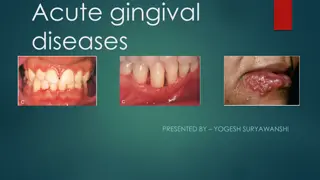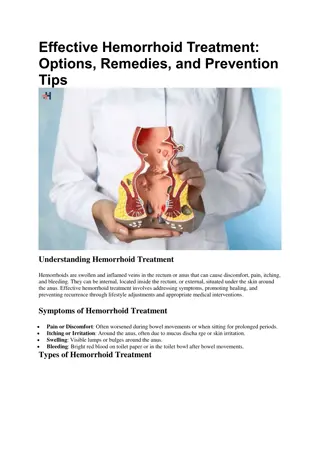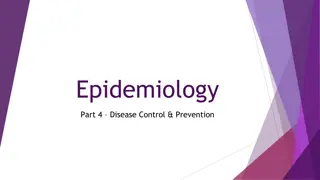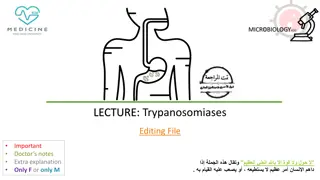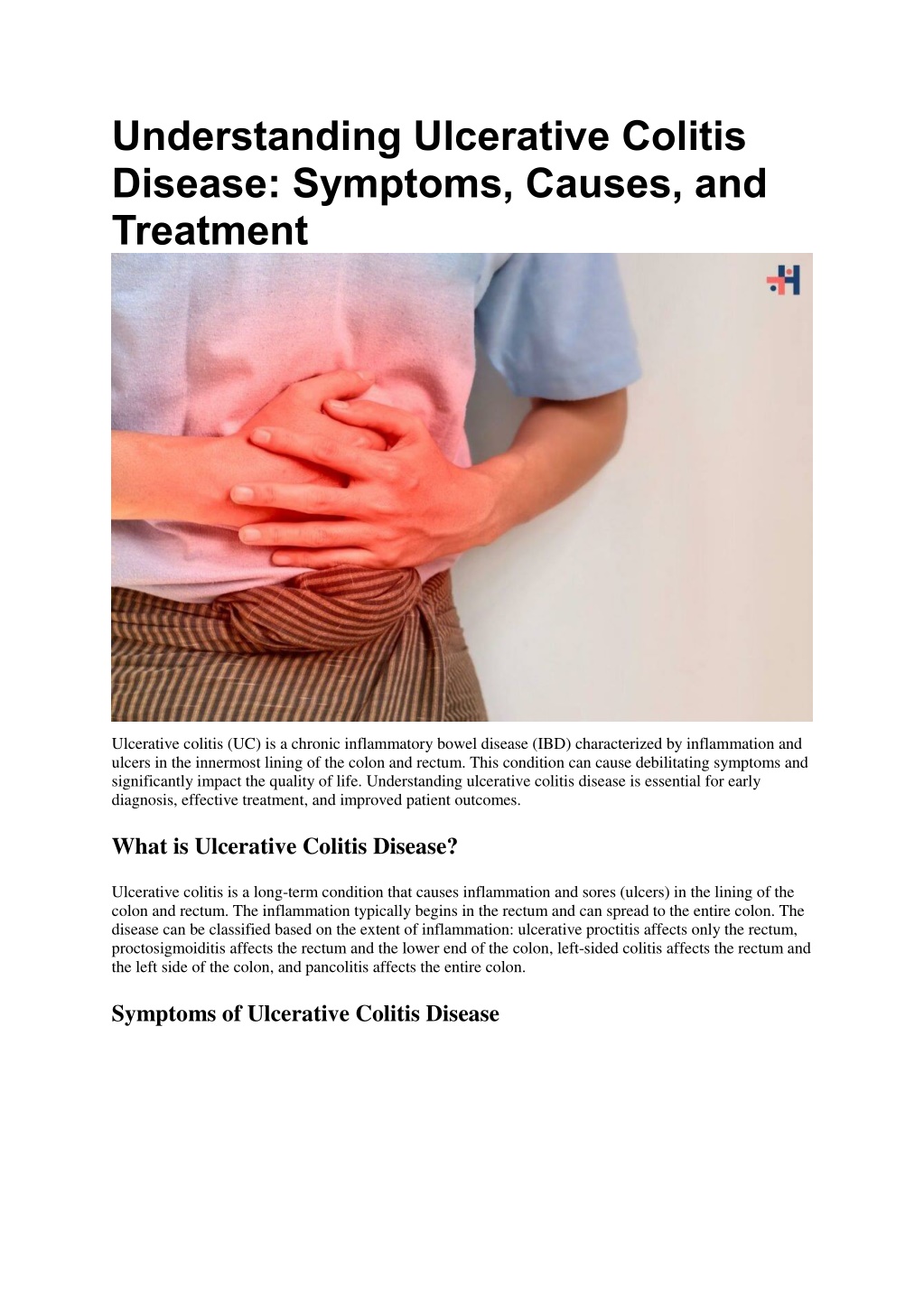
Understanding Ulcerative Colitis Disease | healthcare360
Understanding ulcerative colitis disease is essential for early diagnosis, effective treatment, and improved patient outcomes.
Uploaded on | 0 Views
Download Presentation

Please find below an Image/Link to download the presentation.
The content on the website is provided AS IS for your information and personal use only. It may not be sold, licensed, or shared on other websites without obtaining consent from the author. Download presentation by click this link. If you encounter any issues during the download, it is possible that the publisher has removed the file from their server.
E N D
Presentation Transcript
Understanding Ulcerative Colitis Disease: Symptoms, Causes, and Treatment Ulcerative colitis (UC) is a chronic inflammatory bowel disease (IBD) characterized by inflammation and ulcers in the innermost lining of the colon and rectum. This condition can cause debilitating symptoms and significantly impact the quality of life. Understanding ulcerative colitis disease is essential for early diagnosis, effective treatment, and improved patient outcomes. What is Ulcerative Colitis Disease? Ulcerative colitis is a long-term condition that causes inflammation and sores (ulcers) in the lining of the colon and rectum. The inflammation typically begins in the rectum and can spread to the entire colon. The disease can be classified based on the extent of inflammation: ulcerative proctitis affects only the rectum, proctosigmoiditis affects the rectum and the lower end of the colon, left-sided colitis affects the rectum and the left side of the colon, and pancolitis affects the entire colon. Symptoms of Ulcerative Colitis Disease
The symptoms of ulcerative colitis can vary depending on the severity of the inflammation and the extent of the disease. Common symptoms include abdominal pain and cramping, diarrhea often with blood or pus, and an urgent need to defecate. Other symptoms may include weight loss, fatigue, fever, and anemia. Some individuals may experience periods of remission, where symptoms subside, followed by flare-ups, where symptoms worsen. In more severe cases, ulcerative colitis can lead to complications such as severe bleeding, perforated colon, severe dehydration, liver disease (rarely), osteoporosis, inflammation of the skin, joints, and eyes, and an increased risk of colon cancer. These complications highlight the importance of early diagnosis and effective management of the disease. Causes of Ulcerative Colitis Disease
The exact cause of ulcerative colitis is unknown, but it is believed to result from a combination of genetic, environmental, and immune system factors. Genetics play a role, as individuals with a family history of IBD are at a higher risk of developing the condition. Environmental factors, such as diet, stress, and exposure to certain infections, may also contribute to the onset of the disease. The immune system is thought to be involved, with an abnormal immune response targeting the colon s lining, leading to inflammation. Diagnosis of Ulcerative Colitis Disease Diagnosing ulcerative colitis involves a combination of medical history, physical examination, laboratory tests, and imaging studies. A detailed medical history and physical examination help identify symptoms and rule out other conditions. Laboratory tests, including blood tests and stool samples, can detect signs of inflammation, anemia, and infection. Imaging studies, such as colonoscopy and sigmoidoscopy, allow direct visualization of the colon and rectum to assess the extent of inflammation and collect tissue samples for biopsy. During a colonoscopy, a long, flexible tube with a camera on the end is inserted into the rectum to view the entire colon. This procedure allows the doctor to see the extent of inflammation and take tissue samples (biopsies) to confirm the diagnosis. A sigmoidoscopy is similar but only examines the rectum and the lower part of the colon. Other imaging tests, such as X-rays, CT scans, and MRI scans, may be used to get a more detailed view of the colon and rule out other conditions. Treatment Options for Ulcerative Colitis Disease
Treatment for ulcerative colitis aims to reduce inflammation, manage symptoms, and achieve and maintain remission. Medications are the primary treatment and may include aminosalicylates to reduce inflammation, corticosteroids for short-term use to control flare-ups, immunomodulators to suppress the immune response, and biologics that target specific components of the immune system. In severe cases, surgery may be necessary to remove the affected portion of the colon. Lifestyle modifications, such as dietary changes and stress management, can also help manage symptoms and improve quality of life. Surgery may be necessary for individuals with severe ulcerative colitis who do not respond to medication or develop complications. The most common surgical procedure for ulcerative colitis is a proctocolectomy, which involves the removal of the colon and rectum. After this surgery, a new pathway for waste is created through an ileostomy or ileoanal pouch. An ileostomy involves bringing the end of the small intestine through an opening in the abdomen to create a stoma, where waste is collected in an external bag. An ileoanal pouch, also known as a J-pouch, involves creating a reservoir from the small intestine that is connected to the anus, allowing for more normal bowel movements. Coping Strategies for Living with Ulcerative Colitis Disease: The Importance of Awareness and Education Balanced diet, avoiding trigger foods. Regular exercise: improves health, reduces stress. Stress management: mindfulness, meditation, deep breathing exercises, yoga. Emotional support: family, friends, support groups. Regular follow-up care with a healthcare provider. Raising awareness and educating the public about ulcerative colitis is crucial in promoting early diagnosis and effective management. Misunderstandings and lack of knowledge about the disease can lead to delays in seeking treatment and unnecessary suffering. Public awareness campaigns and health education programs in schools can help educate people about the symptoms, causes, and treatment options for ulcerative colitis. Advocacy for research funding and support for IBD can drive advancements in understanding and treating the disease. Promoting a better understanding of IBD can reduce stigma and improve support for affected individuals.
Awareness campaigns can help dispel myths and misconceptions about ulcerative colitis, such as the belief that it is caused by poor diet or lack of hygiene. Educating the public about the autoimmune nature of the disease and its impact on the digestive system can foster empathy and support for those living with the condition. Health education programs in schools can also promote early recognition of symptoms and encourage timely medical intervention. Advocacy for research funding and support for IBD can drive advancements in understanding and treating ulcerative colitis. Supporting organizations that fund IBD research, such as the Crohn s & Colitis Foundation, can help accelerate the development of new treatments and improve patient outcomes. Advocating for policies that improve access to healthcare and support services for individuals with IBD is also essential. Conclusion Ulcerative colitis disease is a complex chronic inflammatory bowel disease that requires careful management and ongoing support. Understanding the symptoms, causes, and treatment options is crucial for individuals affected by the disease and their caregivers. By raising awareness and promoting education, we can create a more supportive environment for those living with ulcerative colitis, helping them achieve better health and improved quality of life. For anyone experiencing symptoms of ulcerative colitis or knowing someone who is, seeking professional medical advice is essential. Early diagnosis and appropriate treatment can significantly improve outcomes and help individuals lead healthier, more fulfilling lives. Find practical solutions to common challenges through our insightful articles on Healthcare 360 Magazine



